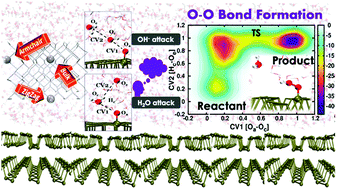Site dependent catalytic water dissociation on an anisotropic buckled black phosphorus surface†
Abstract
Black phosphorus (BP) is unique among 2D materials due to its anisotropic puckered structure. It has been used as a multifunctional catalyst for various purposes. In this study, we performed first principles molecular dynamics simulations to understand the water-splitting reaction on a bi-layer BP surface. We focused on the site-specific aqueous reactivity of the buckled surface. A difference in the axis-dependent reactivity is observed owing to edge defects and exposed sites. Thus, we believe that BP edges, which significantly affect the interfacial water or organic solvent molecules, must exhibit very different edge-dependent reactivity. Experiments suggested the increasing catalytic efficiency of undisturbed BP in the order bulk, few-layered BP, and BP quantum dots. We choose three active sites to investigate the mechanistic details of the OER: the zigzag (ZZ), armchair (AC), and bulk sites. This study will provide insight into the enhanced catalytic activity when more edges are exposed as the active surface. We hope to clarify the reactive pathway in an aqueous solution supported by bi-layer BP by exploring the two different mechanisms for forming the OOH* complex. We explore and report two mechanisms: a simple push–pull reaction for oxygen–oxygen bond formation, the nucleophilic attack by formed OH− and an attack by a water molecule. The free energy barriers procured for mechanism 1 taking place at the zigzag, armchair, and bulk sites are 7.59 ± 0.33, 9.04 ± 0.01, and 12.80 ± 0.09 kcal mol−1, respectively. For mechanism 2 the free energy barriers are 7.62 ± 0.11, 9.15 ± 0.16, and 11.63 ± 0.11 kcal mol−1 for the ZZ, AC, and bulk sites. The interlink between both the mechanisms is established concerning the reported free energy barriers for OOH* formation. The ZZ site is found to lower the activation barrier for the rate-determining step, followed by the AC and bulk.



 Please wait while we load your content...
Please wait while we load your content...